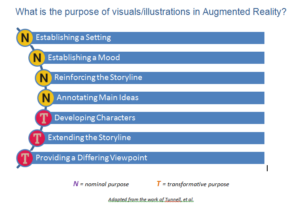A Texas professor, having collected AR children’s books (books that offer innovative AR components to accompany the textual reading) for some time, took the opportunity to ask a group of captive teachers to review these state-of-the-art resources. The teachers spent considerable time examining the AR books and were then fronted this question: “How would you use these in the classroom?”


A few teachers responded that they would demonstrate an AR book to the entire class, and then “leave it in a learning station in their room for children to explore on their own.” Now, that’s a definite curse, by the way—the curse of making something optional in the classroom. When teachers make an experience optional, it can mean one of two things. First, it could mean they don’t know how to use the resource, so the teacher plops it in a learning center to see if kids can take to it on their own. Last, it could mean they don’t see the technology resource as having a central role in instruction.
 Dr. M.E. GreenThe professor in question, Marybeth Green (Associate Professor of Instructional Technology and Graduate Coordinator for the Instructional Technology Program at Texas A&M University-Kingsville) came to the same stark realization:
Dr. M.E. GreenThe professor in question, Marybeth Green (Associate Professor of Instructional Technology and Graduate Coordinator for the Instructional Technology Program at Texas A&M University-Kingsville) came to the same stark realization:
It occurred to me after the presentation, that the teachers don’t really know how to use the affordances of [AR], because it is so new. It’s a definite growth area for our profession. Not only should we define metacognitive strategies for kids using AR books, we should also define ways in which teachers can make use of the affordances of [AR].
With that challenge in mind, Dr. Green began making some interesting connections. If you think about it, AR uses visual images to convey story elements much in the same way illustrations in a children’s book assist a vital storyline. Dr. Green found some interesting scholarly work on how 2D illustrations in children’s picture books fulfil specific literary purposes. (See Tunnell, M. O., Jacobs, J. S., Young, T. A., & Bryan, G. (2016). Children’s literature, briefly. Boston: Pearson.) She began to think in terms of applying the ideas in this book in two new ways: as a framework for a) evaluating high potential AR/MR resources for the classroom and b) helping teachers know exactly how to use AR/MR in the classroom in the most effective ways.
Adapting the ultimate purposes of book illustration proposed by Tunnell, et al. to the cyberific aims of its high-tech dopplegangers, AR/MR, Dr. Green envisions the following ways in which AR/MR can be leveraged to visual advantage:
I believe that Dr. Green suggests that some uses of AR/MR appear merely nominal, while others can be more transformative in nature, offering much more in the way of instructional firepower. It is in this difference, this added value, that excellent AR/MR becomes separated from the ordinary; that their more transformative uses can help educators settle in with using AR/MR more meaningfully. It is in this separation—from nominal to transformative—that technology resists the pull towards one-off placement in the classroom. Only in this way can the technology finally hope to escape the curse of being optional. And if you think hard about it, that’s the requisite aspiration of any sensible display manufacturer: to escape the slow-drip death grip of optionality in the classroom.
Certainly, this framework provides us with some initial clues about combining the right content and more appealing use cases in order to succeed in the fickle and often inscrutable education market. Aiming AR/MR product demonstrations at the transformative, and not the nominal, may prove more effective with educators.
So the story’s not over. In a future installment in this series, I am going to translate Dr. Green’s ideas into practical business speak, showing how to increase click-through, traffic and leads; and demonstrating how to smartly showcase your core technology while employing an emerging meme (like AR/MR). – Len Scrogan

